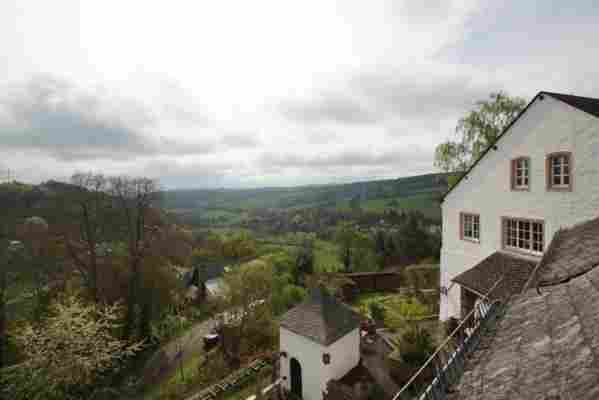A grass-covered hillside makes for a picturesque setting for your dream home, but the process of bringing that picture to life is more complicated than it would be for the average dwelling. Building a house on a sloped lot presents unique challenges that you need to be aware of to ensure the rewards for you are worth the additional costs and longer construction time.


How Do You Build on a Sloped Lot?
There are two ways to build a house on a sloped lot: using the “cut and fill” method, or making use of stilts.
Cut and fill refers to the process of leveling out the ground for the foundation by adding soil, removing it, or both. Soil may be brought in to “fill” the plot and make it level, or it can be dug (“cut”) from the slope and either trucked out or used to shore up retaining walls for the home. Depending on the grade, soil conditions, and other factors, cutting and filling can make construction multiple times more expensive than that for a home on a flat site.
Using stilts is an alternative to cutting into the slope that involves using a crane to lift the home onto supporting wood or steel columns. This can be a much more cost-effective method than cut and fill and can also open up the realm of possibilities for home placement, such as building out over trees or water.
Why Build on a Sloping Site?
It’s no accident that some of the most coveted homes in the world are built on slopes. Here’s why:

What Are the Major Challenges of Building on Sloping Land?
The biggest hurdles boil down to two main factors: the gradient of the slope and whether the lot is upslope or downslope.
You can get a rough idea of how challenging a particular site will be to build on by its gradient rating. Less than 10% incline is considered slight and is the easiest to build on, while 11-20% is considered moderate. Anything above 20% is deemed steep. Beyond about 15%, costs begin to increase significantly as the risks become greater and the work becomes more difficult.
An upslope plot (where what will be the front of the house rises up to the back) is also more challenging than a downslope plot. These types of plots usually require some amount of cutting or even blasting, plus transporting and disposing of rocks and soil.
Additional Foundation Work – Time & Cost
It’s not unheard of to have houses built on grades of as much as 50%; however, the cost of the complex foundation systems required for such houses is often more than the cost of an entire house on flat ground.
But even moderately sloped sites typically require more concrete, deeper excavation by specialized excavation equipment or blasting, retaining walls or terraces, and specialized solutions for drainage and septic systems. All that extra labor and materials needed to ensure the house is up to code and safe to inhabit mean higher costs and longer construction times.
Water – Drainage & Sewage
If you’ve ever seen footage of the effects of mudslides, you’ll understand why proper attention to drainage — for both surface and subsurface water — is absolutely crucial to building on a slope.
Rainfall runoff has to be redirected away from your home’s foundation, without endangering any neighboring properties with water flows and without flooding public roads. Retaining walls have to be “tanked” (waterproofed) and drained to prevent water from pooling there. Swales and culverts can usually be used to channel the runoff to stormwater drains or soakaways (holes dug in the ground and filled with rubble that allow surface water to percolate back into the ground).
If your home will have a full basement that will be located below the seasonal high water table, subsurface water leaking in can become an issue. Workarounds range from the elegant (French drains and/or crushed stone beneath the foundation) to the functional (a sump pump in the basement during rainy season).
Finally, sewage treatment can be tricky depending on where your home is relative to the sewage line. If the line is uphill, you may need to install a pump, and if it’s downhill, you may have to install tumble bays to slow the flow to a reasonable rate.
Storage of Fill Soil & Staging Areas
If your plot requires cutting, the resulting extra soil will either have to be transported out or stored somewhere nearby if it is to be used for filling. Even if you’re not cutting, you’ll need a staging area for vehicles, equipment, and deliveries. If you’re only filling, you’ll have to have soil trucked in to the site, a costly expense that varies widely with geography, so we highly recommended getting estimates.
Access to the House
Access to the property — for both you and your contractors — is an important factor to consider in your calculations, as well. Property that may seem like a steal initially could run up high costs for additional grading if there’s no good way to access it. Switchback and curved driveways are helpful and attractive, but small properties that don’t have room for them may have no choice but to install a steep driveway that can be hazardous in inclement weather.
Replenishing the Construction Site
Over the weeks or months it takes your home to be built, as trucks come and go, heavy equipment is parked, and construction materials are scattered about, any natural plants on your new home site are going to take a beating. Replanting with cultivated plants or waiting for the natural flora to grow back may require many months of waiting before the property gets the look you’d imagined when you first began the new home-building process.
Soil Type
The type of soil of a sloped property can be easily overlooked but could pose a problem for home builders. While granular soils (gravel, sand, or silt with little or no clay) drain well and can bear high loads, soils with high clay do neither well. Certain clays can damage foundations by swelling or expanding when wet or frozen and may require expensive engineering fixes or additional fill of granular soil.
Rock ledges near the surface can also present difficulties with drainage and septic systems. Often the most budget-friendly solution is to work around them, as blasting them out is costly and carries a liability risk to neighboring foundations.
Landscaping
Flat ground is of course easier to work with, but with the right planning, a sloped lot can be the canvas for landscaping that sets you apart from ordinary front yards. You’ll want to put down plants that can take root on an incline. Ground cover plants with deep roots such as English ivy and Euonymus vines can help reduce erosion and prevent weeds. For planting in retaining walls, Better Homes & Gardens recommends plants that grow well in crevices such as creeping phlox, thyme, and candytuft. They also suggest waterfalls, potted plants, and decorated switchbacks for sprucing up sloped yards.
Legal Eagle Contractors is an award-winning full-service building and remodeling company for residents of Houston, TX with decades of experience in building custom homes and home additions .









